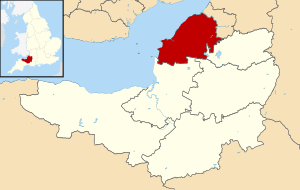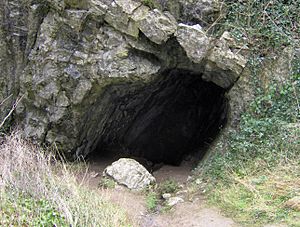List of scheduled monuments in North Somerset facts for kids
North Somerset is a special area in England that manages itself. It's part of the bigger area called Somerset, but it has its own government. The main office is in Weston-super-Mare. North Somerset shares borders with other areas like Bristol and Bath and North East Somerset. It also has two areas that elect people to the UK Parliament: Weston-super-Mare and North Somerset.
A "scheduled monument" is a really important old place or structure in the country. It gets special legal protection from the government. English Heritage helps find these sites. These monuments can be anything built by people, even if you can't see them above ground. They range from ancient standing stones and burial sites from thousands of years ago, to Roman ruins, and medieval buildings like castles and monasteries. There are even more recent sites from the Industrial Revolution or the World Wars.
North Somerset is home to 68 of these amazing scheduled monuments! The oldest one is Aveline's Hole, a cave where bones from the Mesolithic period (Middle Stone Age) were found. This makes it the oldest scientifically dated cemetery in Britain! You can also find many ancient burial mounds called Neolithic tumuli. There are also several Iron Age hillforts, like the one at Worlebury Camp. Another Iron Age hillfort, Dolebury Warren, was later used as a place to raise rabbits in medieval times. From the Romano-British period, there are sites like old Roman villas. Later, from the Middle Ages, you can find motte-and-bailey castles, such as Locking Castle, and old church crosses. There are also several places where medieval villages used to be, but are now deserted. Woodspring Priory is a former Augustinian monastery built in the early 13th century. More recent sites include the Elms colliery (a coal mine) and glassworks in Nailsea from the Industrial Revolution. The newest monuments are two Palmerstonian gun batteries, built in the 1860s, on the island of Steep Holm.
Contents
Amazing Ancient Sites
North Somerset is packed with incredible historical sites that tell us about life long ago. Here are some of the most interesting ones:
Aveline's Hole: Britain's Oldest Cemetery
Located in Burrington Combe, Aveline's Hole is a limestone cave. It's famous because it holds the earliest scientifically dated cemetery in Britain! Scientists found human bone fragments from over 50 different people here. These bones are thought to be around 10,200 to 10,400 years old. Imagine how long ago that was!
Iron Age Hillforts: Ancient Defenses
North Somerset has several impressive Iron Age hillforts, which were like ancient fortified towns built on hills for protection.
- Banwell Camp is a large hillfort near Banwell. It has multiple defensive walls and ditches. Some older items found here even date back to the Bronze Age and Stone Age.
- Worlebury Camp is another huge hillfort on Worlebury Hill in Weston-super-Mare. It was built with many walls and ditches to protect its people. Archaeologists have found nearly one hundred storage pits dug into the rock, some containing human remains and ancient coins.
- Dolebury Warren near Churchill is a very large hillfort. It was built during the Iron Age and continued to be used into the Roman period. Later, in medieval times, it became a rabbit farm, which is where the "Warren" in its name comes from. It's now a special nature reserve too!
- Cadbury Camp in Tickenham is a well-preserved Iron Age hillfort. It was used from the Bronze Age all the way through the Roman and Anglo-Saxon periods. The National Trust helps look after it.
- Cadbury Hill near Congresbury is another important Iron Age hillfort. It was built with strong walls and ditches. You can still see the remains of round houses inside. It was even re-fortified between 430 and 480 AD, showing it was important for a long time.
Mysterious Burial Mounds: Barrows
North Somerset has many ancient burial mounds, often called barrows or tumuli. These were built to bury people during the Neolithic (New Stone Age) and Bronze Age.
- There are several bowl barrows and bell barrows around places like Weston-super-Mare, Nempnett Thrubwell, and Winford. These are round mounds of different sizes.
- The Fairy Toot near Nempnett Thrubwell is a large, oval-shaped burial mound. It's a type of chambered long barrow, meaning it has stone burial chambers inside. When it was explored long ago, it was found to contain two rows of cells made of huge stones.
Roman Villas: Ancient Homes
The Romano-British period left its mark with several Roman villas. These were large country houses for wealthy Romans or Romanized Britons.
- A Roman villa was found near Yatton, with mosaic floors and hypocausts (underfloor heating systems). Coins and pottery from 250 to 360 AD were discovered here.
- Another Roman villa site is in Banwell, which also had a bath house with a mosaic floor.
- The North Weston Roman villa near Portishead is a buried Roman villa site. A medieval barn was later built over it.
Medieval Castles and Crosses
The Middle Ages brought castles and religious structures to the area.
- Locking Castle was a motte-and-bailey castle on Carberry Hill. It was built in the 12th century. A "motte" is a large mound, and a "bailey" is a walled courtyard next to it.
- Castle Batch in Worle is another motte, built by a Norman lord between 1066 and 1086. It's a mound about 3 meters high and 42 meters wide, surrounded by a ditch.
- Many churchyard crosses can be found in places like Backwell, Chelvey, and Congresbury. These stone crosses often date from the 14th or 15th centuries and were important religious symbols. Some have been repaired or had new parts added over the centuries.
- Woodspring Priory near Kewstoke is a former Augustinian monastery founded in the early 13th century. It was dissolved in 1536 but many of its buildings, including the church, still stand today. It's now looked after by the Landmark Trust.
Industrial Revolution Sites
More recently, the Industrial Revolution left its mark with sites like:
- Elms Colliery in Nailsea was a coal mine that operated from the late 18th century until the 1850s. Three buildings from the colliery still survive.
- Nailsea Glassworks also in Nailsea, was a glass factory that ran from 1788 until 1874. You can still see parts of the kilns and other buildings.
- The Littleton gunpowder works at Powdermill Farm in Winford opened around 1650. It became the biggest gunpowder factory in South West England by the mid-1700s, closing after the Napoleonic Wars in the 1820s.
Victorian Defenses
- On the island of Steep Holm in the Bristol Channel, you can find two Palmerstonian gun batteries. These were built in the 1860s as part of a line of defenses to protect Bristol and Cardiff. They were even updated and used in both World War I and World War II!
Images for kids
See also
- Scheduled Monuments in Somerset
- Grade I listed buildings in North Somerset
- Grade II* listed buildings in North Somerset
































